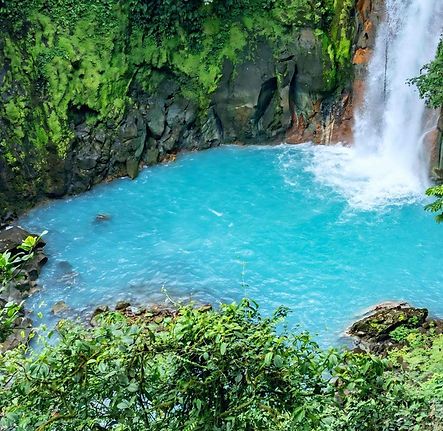Tenorio Volcano
A Natural Paradise in Costa Rica
Tenorio Volcano is one of the most impressive and lesser-known destinations in Costa Rica. Located in the Guanacaste region in the north of the country, this volcano is famous not only for its geothermal activity but also for its stunning landscapes, the various ecotourism options it offers, and, above all, the unique Rio Celeste, whose characteristic turquoise color attracts thousands of tourists each year.

Location and Access
Tenorio Volcano is located within the Tenorio Volcano National Park, in the province of Guanacaste, near the border with Alajuela. This park is about 3 hours by car from San José and around 2 hours from Liberia, the nearest city. Access to the park is via road, and although some routes are gravel, the path is generally in good condition for 4x4 vehicles.
The park is less crowded compared to other well-known volcanoes in Costa Rica, making it an ideal destination for travelers looking for a quieter, more natural environment.
History and Geological Formation
Tenorio Volcano is an active stratovolcano, part of the Guanacaste Volcanic Range, one of Costa Rica's main mountain chains. Though its eruptive activity has been sporadic, the volcano still shows signs of geothermal activity, including fumaroles and hot springs.
The volcano stands at an elevation of 1,916 meters (6,286 feet) above sea level and is believed to have formed around 1 million years ago, with volcanic activity continuing over the centuries. One of its most fascinating features is the presence of several hot springs as well as the Celeste River, whose extraordinary turquoise hue is caused by a unique mixture of minerals and volcanic compounds that react with the oxygen.
Rio Celeste: A Unique Natural Phenomenon
One of the main attractions of Tenorio Volcano is the spectacular Rio Celeste, a river that, due to a special mixture of minerals like calcium sulfate and aluminum sulfate, acquires a bright turquoise color, creating one of the most stunning sights in the country.
This natural phenomenon occurs along the river and in the nearby lakes, where the water turns a vibrant blue, which has attracted both tourists and scientists from around the world. The color of the river changes along its course, from light blue to emerald green, depending on the concentration of minerals and weather conditions.
The Rio Celeste is one of the park's main attractions and can be explored through various trails that lead visitors to the river, its waterfalls, and the thermal areas. The most popular trail is the Rio Celeste Trail, which takes tourists through various key spots, such as the Hot Springs and the Rio Celeste Waterfall, a stunning 30-meter (98-foot) waterfall that cascades into a natural turquoise pool.
Flora and Fauna of Tenorio Volcano National Park
Tenorio Volcano National Park is a refuge for biodiversity, housing a wide variety of ecosystems, ranging from rainforests to cloud forests. This is due to its altitude and location in a humid tropical zone, making it an ideal habitat for many species of flora and fauna.
Flora
The park boasts lush and diverse vegetation, primarily consisting of species typical of tropical rainforests. Common trees include oak, guachipelín, guácimo, poma rosa, and cedar, along with a variety of epiphytes such as bromeliads, ferns, and orchids. The area is also home to many species of mosses and lichens that thrive in the park's humid, shaded environment.
Fauna
The park is home to a wide range of animals, many of which are difficult to spot due to the dense vegetation. Mammals found in the park include the puma, jaguarundi, tapir, and several species of monkeys, such as the howler monkey and the white-faced capuchin monkey.
Birdwatchers will also find plenty to explore, as the park is home to more than 200 species of birds. Some of the most notable include the toucan, trogon, and woodpecker. The park also hosts reptiles such as the green iguana, fer-de-lance snake, and several species of frogs, which can be found in the park’s pools and moist areas.
Read more about Tenorio Volcano National Park on the SINAC site: Read more
Menu
Tours in Manuel Antonio
Powered & Managed by Costa Rica Jade Tours
%20(1)%20(1)_950x630_edite.jpg)
%20(1)%20(1)_958x630.jpeg)
%20(1)%20(1)_941x630.jpeg)
%20(1)%20(1)_952x630.jpeg)
%20(1)_941x630.jpeg)
%20(1)%20(1)_953x630.jpeg)